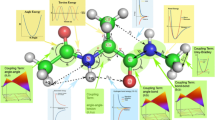Summary
Large-scale computations for biomolecules are dominated by three levels of theory: rigorous quantum mechanical calculations for molecules with up to about 30 atoms, semi-empirical quantum mechanical calculations for systems with up to several hundred atoms, and force-field molecular dynamics studies of biomacromolecules with 10,000 atoms and more including surrounding solvent molecules. It can be anticipated that increased computational power will allow the treatment of larger systems of ever growing complexity. Due to the scaling of the computational requirements with increasing number of atoms, the force-field approaches will benefit the most from increased computational power. On the other hand, progress in methodologies such as density functional theory will enable us to treat larger systems on a fully quantum mechanical level and a combination of molecular dynamics and quantum mechanics can be envisioned. One of the greatest challenges in biomolecular computation is the protein folding problem. It is unclear at this point, if an approach with current methodologies will lead to a satisfactory answer or if unconventional, new approaches will be necessary. In any event, due to the complexity of biomolecular systems, a hierarchy of approaches will have to be established and used in order to capture the wide ranges of length-scales and time-scales involved in biological processes. In terms of hardware development, speed and power of computers will increase while the price/performance ratio will become more and more favorable. Parallelism can be anticipated to become an integral architectural feature in a range of computers. It is unclear at this point, how fast massively parallel systems will become easy enough to use so that new methodological developments can be pursued on such computers. Current trends show that distributed processing such as the combination of convenient graphics workstations and powerful general-purpose supercomputers will lead to a new style of computing in which the calculations are monitored and manipulated as they proceed. The combination of a numeric approach with artificial-intelligence approaches can be expected to open up entirely new possibilities. Ultimately, the most exciding aspect of the future in biomolecular computing will be the unexpected discoveries.
Similar content being viewed by others
References
Almhof, J. and Luthi, H.P., In Jensen, K.F. and Truhlar D.G., (Eds.) Supercomputer Research in Chemistry and Chemical Engineering, ACS Symposium Series 353, American Chemical Society, Washington, D.C., 1987, p. 35.
Recently (Cray Research Inc. press release November 18, 1987), Seymour Cray projected the performance of his CRAY-4, which is now in its initial planning stage, to be 1000 times that of the CRAY-1 delivered in 1976. If we assume a typical development cycle of 5 years, a factor of 1000 in throughput performance would have then been achieved within about two decades.
Hohenberg, P. and Kohn, W., Phys. Rev. B 136 (1964) 864–871.
Kohn, W. and Sham, L.J., Phys. Rev. A, 140 (1965) 1133–1138.
Wimmer, E., Freeman, A.J., Fu, C.-L., Cao, P.-L., Chou, S.-H. and Delley, B., In Jensen, K.F. and Truhlar, D.G. (Eds.) Supercomputer Research in Chemistry and Chemical Engineering, ACS Symposium Series 353, American Chemical Society, Washington, D.C., 1987, p. 49.
McCammon, J.A. and Harvey, S.C., Dynamics of Proteins and Nucleic Acids, Cambridge University Press, Cambridge, 1987 (and references therein).
Wipke, W.T. and Hahn, M.A., Pierce T.H. and Hohne, B.A. (Eds.) Artificial Intelligence Applications in Chemistry. ACS Symposium Series 306, American Chemical Society, Washington, D.C., 1986, p. 136.
Klein, T.E., Huang, C., Ferrin, T.E., Langridge, R. and Hansch, C., ibid., p. 147.
Singh, U.C., QUEST 1.0 Users Manual, Department of Pharmaceutical Chemistry, University of California, San Francisco, CA 94143, 1986.
Car, R. and Parrinello, M., Phys. Rev. Lett., 55 (1985) 2471–2474.
Allan, D.C. and Teter, M.P., Phys. Rev. Lett. 59 (1987) 1136–1139.
Amdahl, G., American Federation of Information Processing Society Conference Proceedings, Spring Joint Computer Conference 3 (1967) 483.
Wilson, K.G., In Matsen F.A. and Tajima, T. (Eds.) Supercomputers — Algorithms, Architectures, and Scientific Computing, University of Texas Press, Austin, 1986, p. 431.
Author information
Authors and Affiliations
Rights and permissions
About this article
Cite this article
Wimmer, E. Future in biomolecular computation. J Computer-Aided Mol Des 1, 283–290 (1988). https://doi.org/10.1007/BF01677277
Issue Date:
DOI: https://doi.org/10.1007/BF01677277




